King Edward VII Banished To Palestine
QUOTE
The first EVER photographs of a Royal tour: Banished to the Holy
Land after a notorious sex scandal, Edward VII spent his days smoking and
shooting crocodiles before returning home... with a tattoo
When the 20-year-old Bertie, Prince of Wales, steamed into Cairo station on the train from Alexandria in March 1862, the first thing he did was jump onto a donkey and ride through the streets of the city.
After the black mourning of his father Prince Albert’s recent death and the February gloom he had left behind in England, Cairo was liberating. The Prince was in high spirits at the start of this Royal tour of Egypt and the Holy Places of Palestine and Syria.
This trip set the template for the Royal
tours we know today, not least because it was the first that people could
actually see. The Royal advisers made a pioneering decision to take an official
photographer, 42-year-old Francis Bedford.
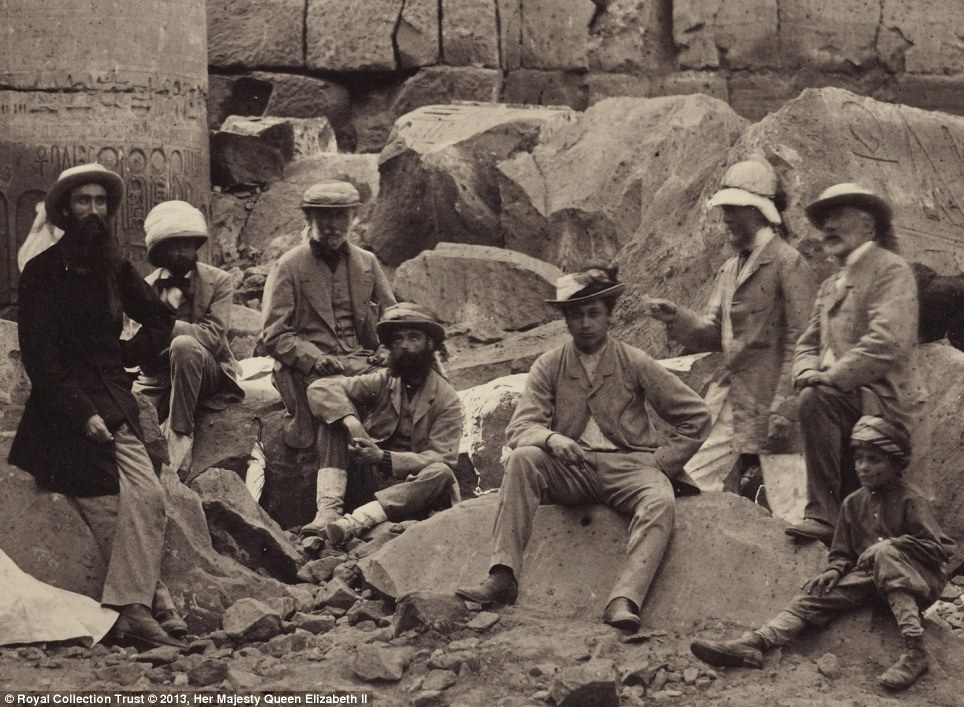
On the rocks: Prince Albert, later King Edward VII,
fourth from right, relaxes with his companions at Thebes during the Royal
tour of Egypt Pictured with the Prince of Wales are, left to right, Robert
Meade, Christopher Teesdale, Robert Bruce, Frederick Keppel, an
unknown man, Dr Stanley and an unknown boy
His extraordinary prints, published here for the first time, show a future king relaxing away from the sorrow and shame engulfing him in England, where his involvement in a sex scandal led his mother to blame him for bringing on his father’s death.
The Royal party is pictured in dramatic, sometimes startling, locations ranging from the Pyramids of Giza to the crumbling Acropolis in Athens. They rode camels, met ‘picturesque’ locals with guns and are seen dining in the shade of precarious ruins.
Then, as now, the Middle East was the flashpoint of international politics. With the Ottoman Empire collapsing, the British were worried the French would control the Suez Canal, then under construction. Winning the friendship of Egypt’s ruler Said Pasha was essential – and this, in addition to other diplomatic tasks, was what Bertie was expected to achieve.
The tour was also intended to address a
crisis rather closer to home. Bertie’s father, Prince Albert, had died suddenly
in December 1861. Many people urged the Queen to cancel the tour. But Victoria
was adamant that Bertie should go.
The widowed Queen seemed paralysed by grief.
She was alone and apparently suffering from a mental breakdown, and many doubted
she was able to rule. The press called for her to share the burden of power with
her eldest son. But Victoria refused to allow Bertie any political role. Sending
him on a four-month tour got him out of the way.
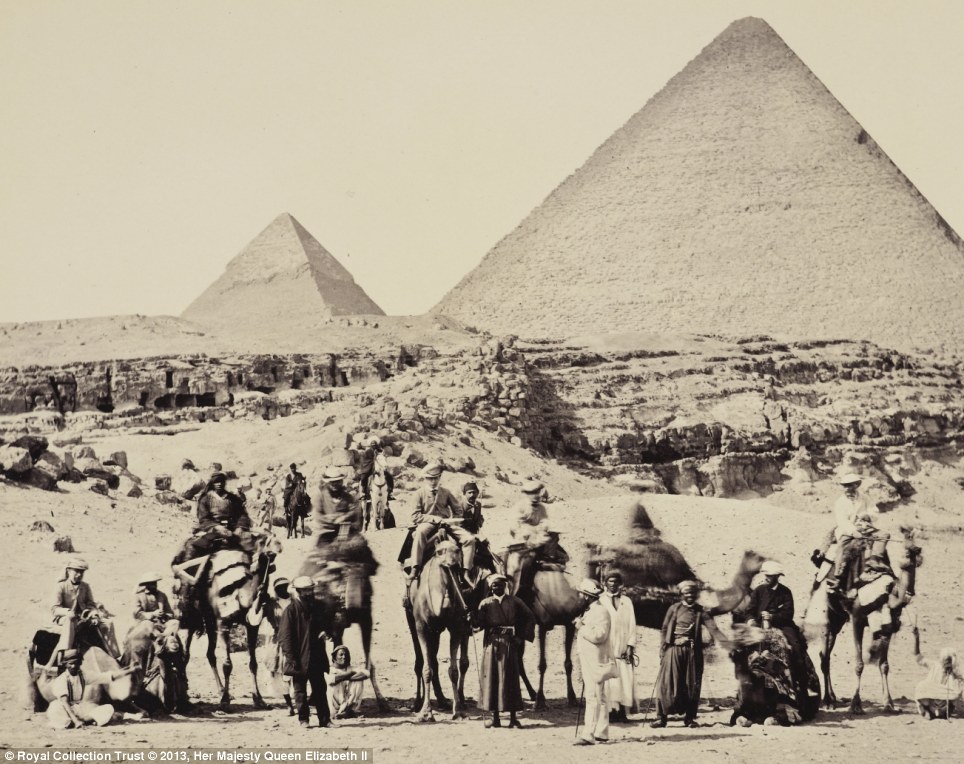
Sands of time: The Royal party pictured in front of
the Pyramids of Giza in March 1862 with the then 20-year-old Prince of Wales
sitting in a light jacket and cap on the third standing camel from left
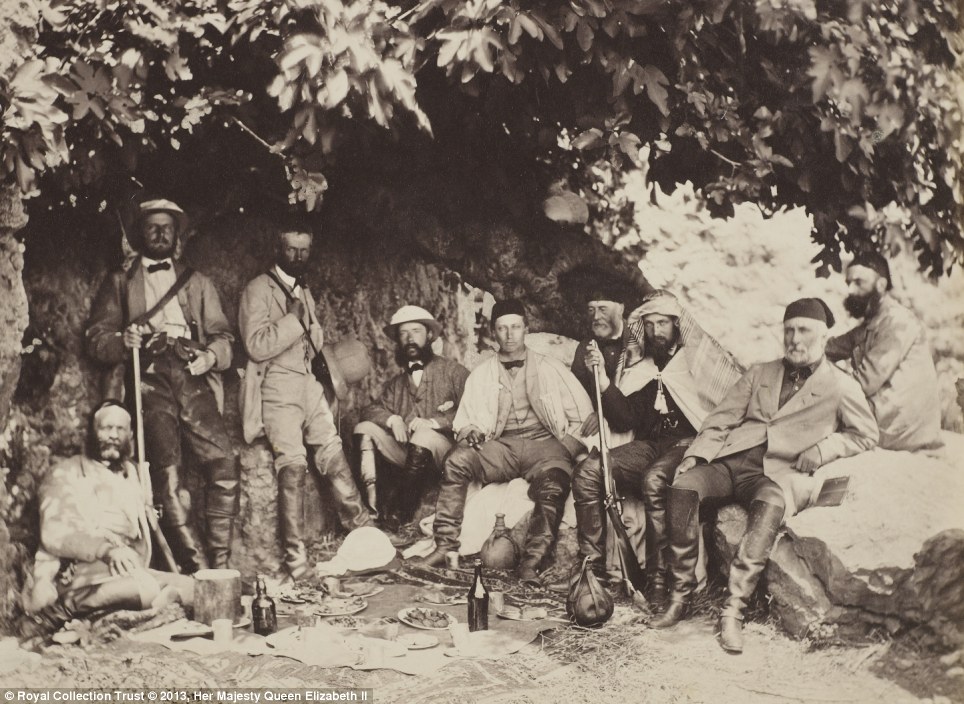
A Royal picnic: 'We lunched under a fig tree at 12 o'clock on the site of where once the city of Capernaum is said to have stood & Mr. Bedford photographed us "en groupe",' the Prince of Wales, fifth from left, wrote in his journal on April 21
Prince Albert was the inventor of the Royal tour as we know it. He had already sent Bertie on a tour of Canada and America in 1860 – with neither artist nor photographer – and this had been a resounding success.
This trip, too, had been planned by Prince Albert shortly before his death. Queen Victoria ordered that Bertie should travel with his entourage, or ‘suite’, in deep mourning. He was forbidden to accept social invitations. She gave instructions to General Bruce, the Prince’s governor, to keep Bertie under strict supervision.
General Bruce was a martinet who had acted as minder when Bertie spent a year first at Oxford University and then at Cambridge. Unfortunately, Bertie was not the studious type. He smoked cigars (which Victoria loathed) and succeeded in making some raffish friends.
In September 1861, Bertie attended a military
camp at the Curragh, near Dublin. Here his brother officers smuggled into his
bed a courtesan named Nellie Clifden. When the story of Bertie’s ‘Fall’ reached
Windsor, his parents were devastated.
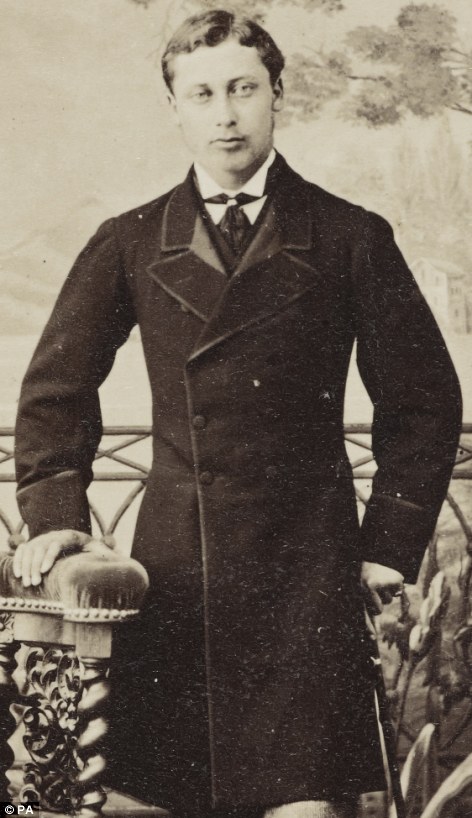
Royal poser: Prince Albert wrote to his friend of a 'lazy life of smoking and drinking coffee' on his travels
Prince Albert travelled to Cambridge to have it out with Bertie. Father and son went for a walk in the rain. Bertie was forgiven. But Albert returned to Windsor mortally ill. Three weeks later, he was dead.
Albert died of typhoid, but Victoria blamed Bertie’s ‘Fall’ for Albert’s death. She was determined to press ahead with the next stage that Albert had planned for Bertie: marriage.
Bertie’s name was already tarnished by his ‘Fall’ and Victoria was determined that her son should not become damaged goods. Bertie was closely chaperoned to prevent him getting up to more mischief.
The Royal party reached Alexandria in
February 1862. Most of the time in Egypt was spent on a boat tour of the Nile.
Arthur Stanley, later Dean Stanley, the Professor of Ecclesiastical History at
Oxford University, came as a guide.
He was disappointed by the Prince, who showed no interest in ancient history. Bertie scrambled up the Great Pyramid very quickly. After that, he refused to see any more. When Stanley proposed a visit to the ruins at Thebes, Bertie replied: ‘Why should we go and see the tumbledown old temple?’
On the boat, Bertie spent his time absorbed in the latest thriller – a novel about murder and adultery called East Lynne by Mrs Henry Wood. He amused himself by shooting from the boat. He shot quails, vultures and crocodiles.
He wrote to his friend at Cambridge: ‘We are leading quite an eastern lazy life, and smoke and drink coffee nearly all day . . . I trust that you have cut the acquaintance of our friend N [Nellie Clifden].’
But Bertie’s insouciance masked a talent for diplomacy. In spite of his mother’s low opinion of his abilities, he had a gift for getting on with people.
Ignoring the Queen’s instructions that he should refuse all invitations, Bertie accepted the lavish hospitality offered by Said Pasha and succeeded in gaining his goodwill.
As King Edward VII, Bertie became the ‘Uncle of Europe’, acting as unofficial ambassador for his country. He played a key part in the making of the Entente Cordiale with France and he dedicated himself to preserving European peace in the run-up to the First World War.
At home, he reformed the monarchy, making it high-profile and glamorous. And it was on this Royal tour of 1862 that Bertie’s talents first became apparent.
From Egypt, the party sailed in the Royal Yacht Osborne to Jaffa, the port of Palestine. They spent five weeks touring the biblical sites on horseback, escorted by 50 Turkish spearmen on horses and camping in tents at night.
Bertie’s Eastern tour was described in the press as a private expedition, with only ‘eight gentlemen’ accompanying the Prince, including photographer Francis Bedford.
In reality, however, there was a large group of assistants, servants, guides and translators who followed the Royal party in order to ease the pains of travel.
One photograph shows the large encampment on the outskirts of Beirut in which the party slept. Each of the gentlemen travelling with the Prince would have had his own personal servant. Stanley took his servant Waters with him, whose talent for ‘bird-stuffing’ was later described as a ‘valuable addition’ to the party.
At Trieste in Italy, Osborne took on board a remarkable amount of food, even by Victorian standards. One delivery contained 30 fowls, 24 pigeons, 36 quails, 200 eggs, 150 oranges and 24 bundles of asparagus, as well as food for the animals – oats, bran, peas, clover and grass.
In Jerusalem, Bertie went so far as to get
himself tattooed – a move that even today’s Royal Princes would appear to
consider a step too far – with the five crosses forming a Crusader’s Jerusalem
cross on his forearm. Bertie was the first English Prince to visit Jerusalem
since Richard the Lionheart, but he got on much better with the Muslims than the
Crusader did.
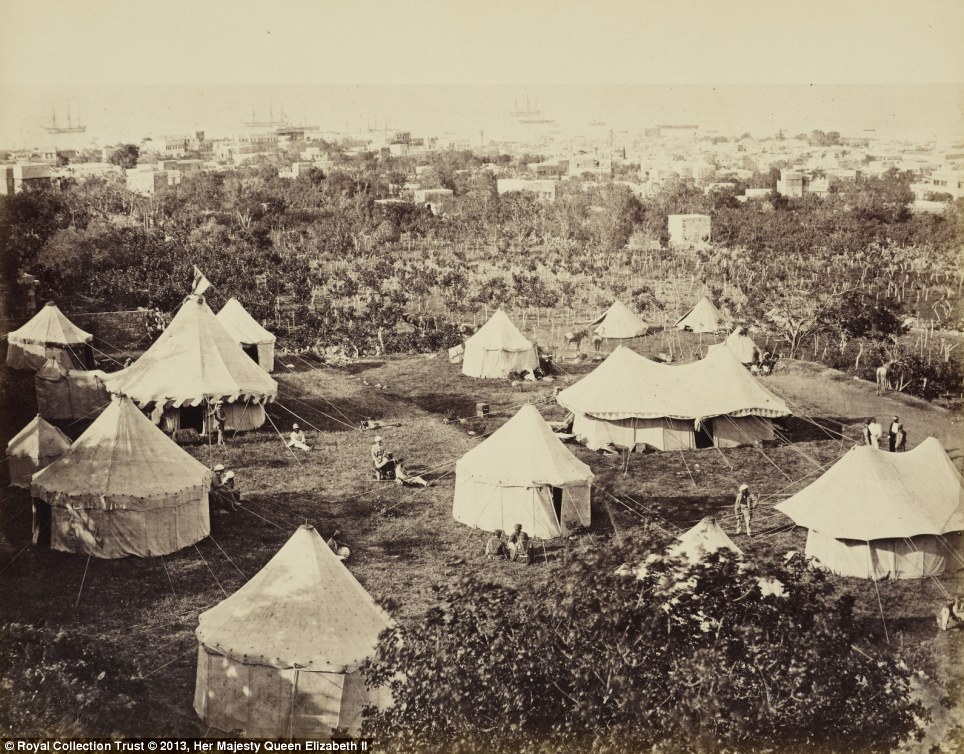
Pitching for Britain: The Royal encampment in
Beirut, Lebanon in May 1862
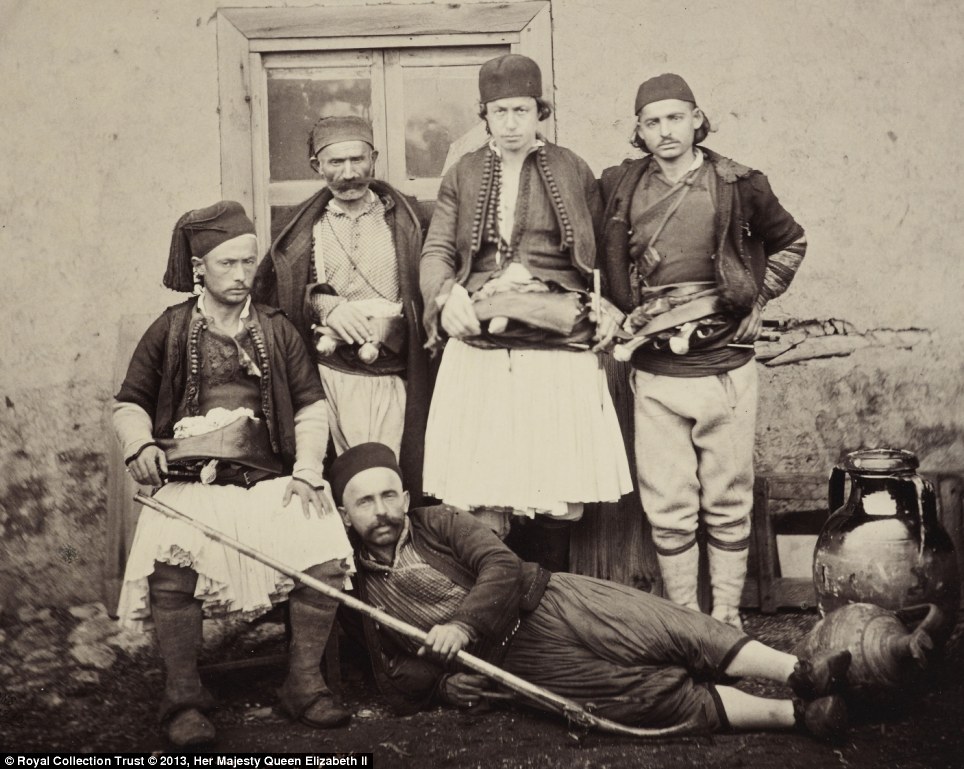
Fez-tive guides: Albanian guides with their 'fez & white petticoats', pictured in Durazzo in February leg of the Royal tour which the Prince described as 'picturesque' in his journal
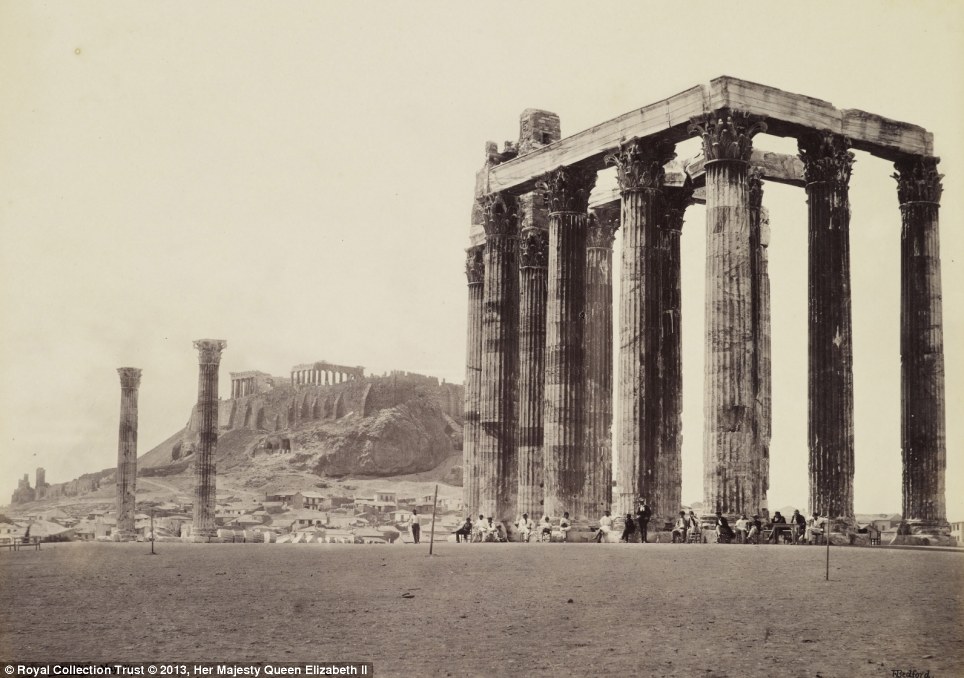
Top tables: Acropolis and the Temple of Jupiter in Athens served as a backdrop for some al fresco dining when the regal party visited Greece in late May
Thanks to Bertie, Bedford gained permission to photograph the mosque at the Dome Of The Rock in Jerusalem – the first-ever photographer to be admitted. Bertie was the first Christian since 1187 to be allowed to enter the mosque of Hebron. The party visited several mosques that had never been seen by Europeans.
'ORDEAL' OF MAKING HISTORY
The new technology used to take
photographs of the Royal tour was just like the Prince: young, modern
and exciting, writes Sophie Gordon, curator with The Royal Collection
Trust.
Few photographs of the Royal party
were taken, probably because of the effort required from everyone to
take a single photograph. Bedford had an assistant and a team of
servants to help him, but the process was lengthy.
Each negative, a heavy sheet of
glass, usually 10in by 12in, had to be prepared with chemicals before
being exposed in the wooden camera for a minimum of ten seconds.
Then the negative had to be developed and fixed inside an airless tent. This would have been filled with toxic fumes and plagued by insects, which would stick to the negatives.
It is not surprising the Prince
described being photographed as ‘an ordeal’, and that in four months
Bedford produced only about 200 successful photographs.
And Bertie was a diplomatic success in Palestine and Syria as well. ‘It is impossible not to like him,’ said Stanley.
Bedford receives almost no mention in the published accounts of the tour, but his photographs are a revelation. In spite of the heat, dust and insects, Bedford succeeded in making more than 200 negatives.
Shortly after Bertie’s return, Queen Victoria recorded in her journal that he showed her the photographs. But the Queen was far more concerned about the health of General Bruce. He contracted fever on the journey and died a few weeks after he reached England.
For Bedford, however, the Royal tour brought critical acclaim. He exhibited his photographs at a Bond Street gallery, and two folio volumes were later published at the exorbitant price of 43 guineas. Recently these rare volumes fetched £55,000.
The Victorians were familiar with many of the scenes that Bedford photographed from the popular watercolours of contemporary Scottish artist David Roberts. But Bedford’s photographs showed the real thing. Never before had the Pyramids and the Holy Places been seen in such detail. (Yet they have never been displayed since Bedford’s exhibition.)
Today, his photographs form an invaluable historical record. It’s possible to judge how much the buildings in the Holy Land had fallen into disrepair under the Ottoman Empire. The photographs also show the Sphinx and the Great Pyramid to be half-covered in sand, where today they have been excavated.
One of the most striking photographs shows the Prince and his party sitting in the ruins of Karnac in Egypt. The photographer has captured the inscriptions on the columns of the temple, but the central figure in the group is Bertie, who seems at ease but also has a natural authority.
If the Royal tour was the making of Bedford as a photographer, it was also the making of Bertie as a future king.
The exhibition Cairo To Constantinople: Early Photographs Of The Middle East will be held at Palace of Holyroodhouse, Edinburgh, from March 8 until July 21 and at Buckingham Palace, from October 31, 2014 until February 22, 2015. For details visit royalcollection.org.uk
Bertie: A Life Of
Edward VII by Jane Ridley is published by Chatto & Windus, priced £30. To order
your copy at £23 with free p&p, call the Mail Book Shop on 0844 472 4157 or
visit mailbookshop.co.uk
UNQUOTE
This is
an extended advert for a book.